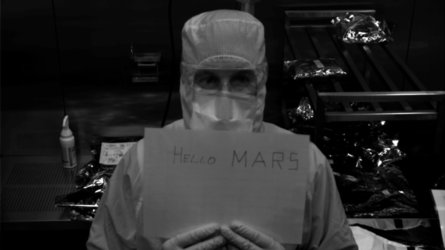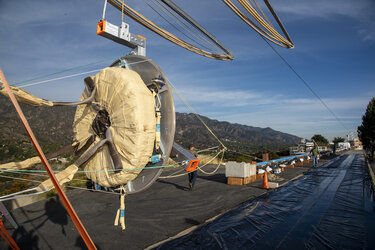Accept all cookies Accept only essential cookies See our Cookie Notice

About ESA
The European Space Agency (ESA) is Europe’s gateway to space. Its mission is to shape the development of Europe’s space capability and ensure that investment in space continues to deliver benefits to the citizens of Europe and the world.
Highlights
ESA - United space in Europe
This is ESA ESA facts Member States & Cooperating States Funding Director General Top management For Member State Delegations European vision European Space Policy ESA & EU Space Councils Responsibility & Sustainability Annual Report Calendar of meetings Corporate newsEstablishments & sites
ESA Headquarters ESA ESTEC ESA ESOC ESA ESRIN ESA EAC ESA ESAC Europe's Spaceport ESA ESEC ESA ECSAT Brussels Office Washington OfficeWorking with ESA
Business with ESA ESA Commercialisation Gateway Law at ESA Careers Cyber resilience at ESA IT at ESA Newsroom Partnerships Merchandising Licence Education Open Space Innovation Platform Integrity and Reporting Administrative Tribunal Health and SafetyMore about ESA
History ESA Historical Archives Exhibitions Publications Art & Culture ESA Merchandise Kids Diversity ESA Brand Centre ESA ChampionsLatest
Space in Member States
Find out more about space activities in our 23 Member States, and understand how ESA works together with their national agencies, institutions and organisations.
Science & Exploration
Exploring our Solar System and unlocking the secrets of the Universe
Go to topicAstronauts
Missions
Juice Euclid Webb Solar Orbiter BepiColombo Gaia ExoMars Cheops Exoplanet missions More missionsActivities
International Space Station Orion service module Gateway Concordia Caves & Pangaea BenefitsLatest
Space Safety
Protecting life and infrastructure on Earth and in orbit
Go to topicAsteroids
Asteroids and Planetary Defence Asteroid danger explained Flyeye telescope: asteroid detection Hera mission: asteroid deflection Near-Earth Object Coordination CentreSpace junk
About space debris Space debris by the numbers Space Environment Report In space refuelling, refurbishing and removingSafety from space
Clean Space ecodesign Zero Debris Technologies Space for Earth Supporting Sustainable DevelopmentApplications
Using space to benefit citizens and meet future challenges on Earth
Go to topicObserving the Earth
Observing the Earth Future EO Copernicus Meteorology Space for our climate Satellite missionsCommercialisation
ESA Commercialisation Gateway Open Space Innovation Platform Business Incubation ESA Space SolutionsLatest
Enabling & Support
Making space accessible and developing the technologies for the future
Go to topicBuilding missions
Space Engineering and Technology Test centre Laboratories Concurrent Design Facility Preparing for the future Shaping the Future Discovery and Preparation Advanced Concepts TeamSpace transportation
Space Transportation Ariane Vega Space Rider Future space transportation Boost! Europe's Spaceport Launches from Europe's Spaceport from 2012Latest

Sterilisation for planetary protection
Thank you for liking
You have already liked this page, you can only like it once!
Carefully wrapped inside this donut-shaped bag is a 35-m diameter parachute that will endure a frenzied six-minute dive into martian atmosphere.
This qualification model is a copy of the largest-ever parachute to open on the Red Planet when it flies on the ExoMars 2022 mission – and it is at least 10 000 times cleaner than your smartphone.
The 64 kg parachute, made mostly of nylon and Kevlar fabrics, has been thoroughly sterilised to reduce its level of contamination for planetary protection. One of the main goals of ExoMars is to search for signs of life on the Red Planet, so any microbes hitchhikingon its ride from Earth would interfere with the investigation and could trigger a false positive – what scientists call ‘forward contamination’.
The potential existence of past and perhaps even present life on Mars requires rigorous sterilisation. Scientists want to be sure that the instruments on the ExoMars rover Rosalind Franklin, only detect signs of indigenous life, but protecting the martian environment from ourselves is equally as important. A planetary protection policy by the Committee on Space Research (COSPAR) details all requirements, in compliance with the United Nations Outer Space Treaty.
The parachute was heated in an oven at 125°C for several days to kill any microbes. The oven is part of ESA’s Life, Physical Sciences and Life Support Laboratory, a state-of-the-art facility in the Netherlands. The Laboratory has also cleaned ExoMars instruments and subsystems, but this second stage parachute is the largest item to be sterilised.
The dry heat steriliser is in the ‘ISO Class 1’ cleanroom, one of the cleanest places in Europe. All air passes through a two-stage filter ensuring less than 10 dust particles no larger than 10 millionth of a metre, or less than the size of the coronavirus.
People working on the ExoMars hardware are the main biohazard. Every day, each of us sheds millions of skin particles. Everyone entering the chamber has to gown up more rigorously than a surgeon before passing through an air shower to remove any remaining contaminants. Watch how to dress to avoid being a ‘bioburden’ in the latest ExoMars vlog.
The parachute will next prove itself in high-altitude drop tests. The whole parachute assembly system, mounted onto a drop test vehicle, will be lifted to an altitude of nearly 30 km by helium balloon. The vehicle will free-fall until the test parachute sequence starts in pressure conditions similar to diving into the martian atmosphere.
The dates of these tests have been postponed due to the coronavirus outbreak, and a new window of opportunity for testing is pending confirmation.
Learn more about the ride to Mars on the ExoMars mission pages.
-
CREDIT
ESA–P. Horváth -
LICENCE
ESA Standard Licence

Heat sterilisation of ExoMars parachute

Sterilising an antenna for Mars

ExoMars – Protection for life on Mars

Parachute bag















 Germany
Germany
 Austria
Austria
 Belgium
Belgium
 Denmark
Denmark
 Spain
Spain
 Estonia
Estonia
 Finland
Finland
 France
France
 Greece
Greece
 Hungary
Hungary
 Ireland
Ireland
 Italy
Italy
 Luxembourg
Luxembourg
 Norway
Norway
 The Netherlands
The Netherlands
 Poland
Poland
 Portugal
Portugal
 Czechia
Czechia
 Romania
Romania
 United Kingdom
United Kingdom
 Slovenia
Slovenia
 Sweden
Sweden
 Switzerland
Switzerland

























